ACTION & ACTION PLANS
Why Sporadic Sightings May Mean that Monk Seal Conservation in Italy is Not a Lost Cause...
Giulia Mo
Italian Central Institute for Applied Marine Research (ICRAM)
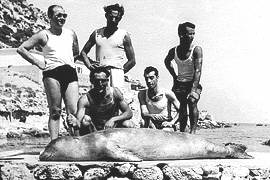
Figure 1. A monk seal caught by local fishermen on the island of Tavolara, Sardinia, in 1953. Direct killing has been a predominant factor in the rapid decline of the species. Photo courtesy Egidio Trainito.
The conservation of the Mediterranean monk seal has been the object of so many discussions, meetings and conferences over the last few decades that it is difficult to ignore a feeling of futility when attempting to write about the status of the species. Yet the difficulties faced in accomplishing this task and the obvious failure in most Mediterranean regions to safeguard the species and to promote the recovery of its remaining nuclei, are a clear indication that the problem remains unsolved. This should be a matter of concern for all citizens of the Mediterranean region.
Perhaps the most difficult, and therefore challenging, aspect of this species’ conservation lies in the dismal reality it epitomises, reflecting as it does the threats faced by many other Mediterranean marine species. It would therefore seem unwise to consign the Mediterranean monk seal to the lists of species destined to disappear, since the failure to rescue the species today portends a more widespread extinction of other Mediterranean marine species in the future.
Closer scrutiny of historical trends highlights a series of actions (and inactions) that offer some explanation for the present day situation in Mediterranean monk seal conservation. These need to be considered in order to understand why the aim of rescuing the species has been so difficult, and to identify which areas still require attention.
International Protection and Legislation
The first international action plan formulated at the Rhodes International Conference in 1978 emphasised the need for a network of monk seal reserves, protection under national legislation, public awareness campaigns, reduction of pollution, studies on the biology of the species, and national conservation programmes incorporating relevant bilateral and multilateral agreements. A gradual shift in priorities in the 1980s instead advocated the importance of protecting the strongest and most concentrated surviving populations in the Aegean and Atlantic, probably because a drastic decline and lack of conservation measures in the western Mediterranean already appeared inevitable (Israëls, 1992). At this time, UNEP, acting through the implementation of the Protocol for Special Protected Areas (SPA) of the Barcelona Convention, called for the creation of protected coastal areas including monk seal habitats, and formulated a regional action plan to promote recovery of the species in the 20 Mediterranean countries adhering to the Convention. The plan encompassed many points envisaged in the first Rhodes conference.
The 1990s have offered the prospect of better environmental integration through efforts to coordinate the actions of EU countries in agreeing upon a common marine environmental policy. The resulting European Union Habitat Directive foresees legislative protection for the monk seal as well as designation of special areas of conservation for endangered species, often referred to as the Natura 2000 Network. However, there are several drawbacks to the Habitat Directive. Implementation is currently delayed, North African and southeast Mediterranean countries are excluded and, perhaps most important of all, it regards marine protection as strictly coastal.
The Barcelona Convention, conceived in the 1970s as a legal instrument against pollution of the Mediterranean sea, was revised in 1995 to incorporate the concept that the Mediterranean is a enclosed regional sea, whose delicate equilibrium requires restoration – through specific conservation measures for marine species – in order to ensure a sustainable environment for future generations. The revised SPA Protocol not only calls for the designation of protected coastal zones but also of open sea areas, crucial for species that cross national maritime boundaries such as marine mammals, sea turtles and sharks. Of most relevance to the fate of the monk seal is the obligation that the protocol and convention impose on all 20 countries to draw up national lists of protected species, and specific action plans for their recovery and conservation. To date, this is the most specific legal tool ever to affect the conservation of Monachus monachus. If interpreted, applied, and respected as the framers originally intended, it could guarantee a thorough and uniform implementation of monk seal conservation activities, and similarly benefit measures to preserve Mediterranean biodiversity as a whole. However, the Convention and its protocols in their revised version, still need to be accepted and ratified by most Mediterranean countries. Until this is achieved by a majority number of the twenty Mediterranean nation states, the convention and its innovative concepts will not enter into force. That such a powerful tool still waits to be accepted despite its formulation in 1995 is perhaps not surprising, considering the vast amount of work and coordination that is required in each sovereign country.
Apparently impervious to the above-related conservation efforts during the last twenty years, the monk seal in the Mediterranean basin has continued to decline. As in many other parts of the Mediterranean, the species began to dwindle in Italy in the early 1960s. In retrospect, it appears that legislative protection of the species and the establishment of monk seal reserves may have suffered from too many delays. Ratification of the Bern and Bonn Conventions in the 1980s provided legal measures against direct killing and disturbance, but little progress was made on the establishment of monk seal reserves.
Protected Areas in Italy
The Italian marine protected area that is often referred to in the relevant literature as a monk seal reserve, is that of the island of Montecristo. This was established in 1979 as a zone of biological protection "in order to save the monk seal from extinction and promote the reproduction and restocking of other species of economic importance". Unlike other zones of biological protection, which envisage restriction only on fishing activities, the Montecristo zone also prohibited navigation and bathing, which in 1988 was extended to the 1 km zone surrounding the island. In 1989 the island was incorporated into the National Park of the Tuscan Archipelago, and in 1996 a Park Authority and park boundaries were established. Marine protection in this area is now conferred upon selected stretches of water extending not more than 1 km around small parts of the islands of Capraia, Giannutri, Montecristo and Gorgona. Within these zones, human access, diving, fishing and navigation are not permitted. In 1997, the nearby island of Pianosa was incorporated into the National Park, with a special 1.8 km protection zone surrounding the island (Scovazzi, 1999). Historical observations of monk seals in this area were frequent, but the last sighting information dates back to 1984 (see figures 2a–d). If monk seal sightings were to still occur in this region, the recently established protected areas could guarantee some of the long-advocated requirements of monk seal reserves.
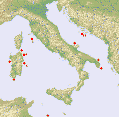 |
Figure 2a. Unconfirmed reported monk seal sightings in Italy and neighbouring countries between 1980-1984 (numbers next to dots indicate number of sightings at location during the 5 year period). |
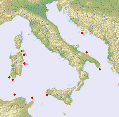 |
Figure 2b. Unconfirmed reported monk seal sightings in Italy and neighbouring countries between 1985-1989 (numbers next to dots indicate number of sightings at location during the 5 year period). |
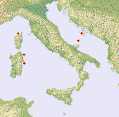 |
Figure 2c. Unconfirmed reported monk seal sightings in Italy and neighbouring countries between 1990-1994 (numbers next to dots indicate number of sightings at location during the 5 year period). |
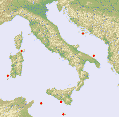 |
Figure 2d. Unconfirmed reported monk seal sightings in Italy and neighbouring countries between 1995-1998 (numbers next to dots indicate number of sightings at location during the 4 year period). |
The reduction of monk seal presence around the islands of Sardinia (see Monk Seal Myths in Sardinia) and Sicily in the 80s warranted additional marine protected areas. Attempts to establish a 2 km marine protected area belt in the Gulf of Orosei in Sardinia in 1987 was subject to local opposition and the Region of Sardinia filed a lawsuit against the State, resulting in the abolishment of the reserve. The reduced sightings and the lack of a reproductively active monk seal population (the last reported reproductive activity in Sardinia was in 1984) drove academic and public opinion to the conclusion that the monk seal was already virtually absent in Italian waters in the mid-1980s. This attitude was probably enhanced by the apparent impossibility of establishing protected areas in order to safeguard the last remaining individuals, and by the lack of definitive information on the species’ distribution and its capacity for movement and dispersal throughout the waters of Italy and of neighbouring countries. Much of the sighting information for the period 1985-1990 (see figure 2b) is drawn from a EU and government commissioned project, and highlights a consistent number of unverified reported sightings in the region of eastern Sardinia (Studiottanta, 1989). The reduction in reported sightings in subsequent years (figs. 2c-2d) must be attributed to a decrease in population as a result of mortality factors long implicated in the species’ decline (direct killing, habitat loss, disturbance to resting and whelping sites). However, this latter decline in observations could also be influenced by the absence of sighting surveys of the kind conducted in earlier years. Unconfirmed sightings reported by fishermen and seafarers demonstrate that observations of monk seals have nevertheless occurred until recently (fig. 2d).
The capacity to establish functioning monk seal reserves in time for them to have a beneficial effect has hindered recovery of the species. This is partly due to the fact that the process of establishing marine protected areas is not an easy one, particularly as it entails a significant shift in Mediterranean environmental awareness, often requiring years of effort. In Italy, the first law on marine reserves was drawn up in 1982 and consisted of a list of 20 potential areas. A second law in 1991 defined three categories of marine special protected areas (State Parks, Regional nature parks, and Nature reserves) and added another 26 locations as potential marine reserves. The legal and bureaucratic process for any of these areas to become both protected and functional is lengthy, requiring a special government decree to define the aims of the area, the type of protection awarded, and the geographical limits involved. Before becoming operational, marine reserves require management bodies and management plans, involving design and research work, appointments and implementation.
To date, Italy has established 12 marine protected areas of relevance to the monk seal – either because of the species’ historical presence, recent sightings, or because of the location’s proximity to countries with surviving populations of seals (blue squares and green dots in fig. 3). Many of these areas still require decrees establishing definitive management systems (i.e. the appointment of a director and management body, and the implementation of the management plan). There are also other locations among the remaining list of potential areas which might be of interest for future monk seal conservation. However, in order for these to be established, they would require governmental decrees legally establishing management bodies (see fig. 3, yellow triangles).
National Action Plan
In Italy, the scientific consulting body to the Ministry of the Environment in matters of marine resources is represented by ICRAM, the Italian Central Institute for Applied Marine Research. As part of its objectives for 1999, ICRAM is involved in formulating national Action Plans for four groups of marine organisms: cetaceans, marine turtles, sharks and Mediterranean monk seals. These Action Plans or documents must furnish the public authorities, namely the Ministry of the Environment, with an appropriate resume of the conservation status and abundance of the species in national waters, of the ongoing threats that they face, of the necessary actions required to mitigate such threats, and the necessary research and protection measures that need to be undertaken. As with similar efforts in other countries, the Action Plans are an interpretative tool for identifying the actions of highest priority and require that recommendations, activities and results be verified and modified according to their effectiveness.
Although monk seal presence in Italy is limited to sporadic sightings gathered somewhat fortuitously, a minimal presence still takes place despite the lack of appropriate conservation measures over the last twenty years. While the lack of current information on the species’ individual movements and habitat use prevents further detailed conclusions, it is crucial to recognise the dire urgency of safeguarding even the last surviving individual(s) and to abandon the long-held notion that seals belong to limited stretches of coastline. Despite the collective interest in discussing the species’ status, very few activities in the original 1978 Rhodes Action Plan have been implemented – in Italy as well as in most other Mediterranean countries – resulting in a "too little, too late" conservation approach. Environmental awareness, necessary for deliberate killing to be deterred, for marine protected areas to be accepted and established, and for biological research and knowledge of the species to advance, have all been slow processes requiring more time than the recovery of the species can permit. With few clearly defined guidelines for countries having no stable reproductive populations of monk seals, the prevailing attitude is that the species is irretrievably lost. Instead, efforts should be exerted on a regional and national scale to identify what concrete actions must be carried out in these areas to encourage recolonisation and recovery.
Considering the proximity of certain portions of Italian coastline to areas having a recurring number of seals, it would hypothetically appear important to consider habitat viability surrounding these populations as an important long-term survival component. In the Ionian islands, a monk seal population has been studied for the last decade by WWF-Greece researchers. On the island of Zakynthos, the monk seal population is estimated to be around 10 individuals, with an annual reproduction rate of 2 pups per year (Zavras, 1998). Observations on photo-identified adult male and female seals in Greece indicate that they are able to move up to, and over, 100 km in a few days (Adamantopoulou et al., 1999). Research on monk seals in Mauritania shows that adult males move up to 40 miles from the coastline just to reach the 80m isobath region where these individuals are believed to be feeding (Gazo et al., 1998). This very preliminary data on animal movements has only recently introduced the notion that some individuals are capable of moving greater distances than previously expected. Such information, coupled with recurrent observations that cave usage by animals in Greece and Turkey appears to be seasonal – as confirmed by the fact that for certain periods of the year seals are not seen along the studied areas of coast – leads to the inevitable hypothesis that monk seals might be moving in a wider distribution. Certain locations around Italy (such as the Tremiti islands, the southern coasts of Puglia, the south-western islands off Sicily and the coasts of Sardinia) are in close proximity respectively to the Croatian island of Pelagruza and the Vis Archipelago, the Ionian coasts, and the Tunisian coasts where some monk seals breed or may still be present. Indeed, these Italian coastal areas are sufficiently close to be utilised by any monk seal individual if we consider the capacity of an individual’s movement and the distances involved (see figure 3).
This hypothesis appears to gain additional support from the sporadic annual sightings in south-western Sicily and Sardinia (figs. 2c-d), which in the last decade have been attributed to vagrant individuals belonging to neighbouring countries (RAC/SPA, 1994). Unfortunately, the conservation implications of the presence of these animals has been largely ignored.
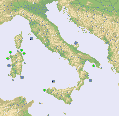 |
Figure 3. Marine parks and protected areas in Italy of relevance to monk seals, due to historical distribution / recent sightings / proximity to foreign locations with known or hypothetical populations. (Blue squares = established protected areas. Green circles = established protected areas where the enactment of definitive management schemes is imminent. Yellow triangles = locations identified as suitable, potential marine protected areas according to national law). |
After two decades of discussion and observation of the species’ decline, evidence suggests that the difficulty lies not so much in what needs to be done (since that is clear from the 1978 Rhodes Action Plan) but how to achieve it in each country. The hard part lies in moving from a regional (Mediterranean) recommendation to a national and local implementation, ensuring that monitoring activities are executed on a permanent basis, and that protection processes are hastened. Action plans discussed at a regional level must find fertile ground at a national level through the various public bodies and ministries concerned, and should be followed up irrespective of the number of seals present in that country’s waters. All nations should be involved in monitoring the species’ presence even if it involves only a few individuals. The approach of nations lying geographically close to those with known, reproductively active populations, needs to be one of active support; those that have stable groups of seals must conserve their habitats; those that have lost them must work towards restoration. The Italian Action Plan for the monk seal will need to focus on cross-collaboration measures, exchange of information on monk seal presence in neighbouring countries, better systems of monitoring, and localised conservation strategies in those areas in proximity to foreign coasts, incorporating both long-term public awareness and monitoring activities. It is hoped that the imminent functional institution of those marine protected areas of geographical interest to the species, and the future addition of other potential locations, can represent an initial step towards monk seal recovery.
The new millennium should see Mediterranean countries adopting (much required) marine environmental policies stemming from EU directives and regional international conventions and protocols. The Mediterranean monk seal lies high on the list of priority species needing intervention. The outcome will depend on how effectively and how fast the adoption of these policies will take place. The answers to the Mediterranean monk seal’s recovery and conservation do not lie very far away from each one of us – they are written in between the lines of a series of general action plans that every Mediterranean monk seal "activist" has had on his/her bookshelf for the last twenty years. The pivotal point lies in how well scientific knowledge will allow the national experts to describe the necessary actions to their respective governments and how much action will then be incorporated into the action plans to ensure that enough can be done in time.
References
Adamantopoulou, S., K. Anagnostopoulou, E. Androukaki, P. Dendrinos, E. Fatsea, E. Tounta, V. Zavras, S. Kotomas. 1999. The Mediterranean monk seals in Greece: research and conservation activities. 13th ECS Conference, European Seals Workshop. Abstracts. Valencia, 5 April 1999, 10 pp.
Gazo, M., T. Pastor, L.M. Gonzalez, F. Aparicio, J.F. Layna, M.A. Cedenilla, H.L. Cappozzo, A. Aguilar. 1998. From birth to independence: a compromising period for Mediterranean monk seal pups in the western Sahara colony. Workshop on the Biology and Conservation of the World’s Endangered Monk Seals. Abstracts. Monaco, 19-20 January 1998, 50 pp.
ICRAM Mediterranean monk seal sighting database (figs. 2a-d) cites some information from other sources:
- Gruppo Foca Monaca-WWF Italia.
- RAC/SPA (1994, 1998): Report on the status of the Mediterranean monk seal (Monachus monachus). UNEP Regional Activity Centre for Special Protected Areas, Tunis.
- Studiottanta s.r.l. (1989): "Progetto Foca Monaca" vol. 1, Commissione delle Comunita’ Europee- Programma Medspa and Ministero dell’Ambiente, Servizio Conservazione Natura, Mestre, pp.35-38.
- Tethys Research Institute.
Israëls, L. 1992. Thirty years of Mediterranean monk seal protection, a review. Nederlandsche Commissie Voor Internationale Natuurbescherming, Amsterdam, pp.19-31.
RAC/SPA. 1994. Statut actuel et tendance des populations du phoque moine (Monachus monachus) de Mediterranee. UNEP Regional Activity Centre for Special Protected Areas, Tunis, 45pp.
Scovazzi, T. 1999. Marine Specially Protected Areas; The general aspects and the Mediterranean regional system. Kluwer Law, Cambridge, MA, pp.102-125.
Zavras, V. 1998. Research continues for Natura 2000 Reserves – Regional News. The Monachus Guardian, vol. 1:1, May 1998. http://www.monachus-guardian.org/mguard01/01regnew.htm. IMMA Inc., Ontario, Canada.





Copyright © 1999 Giulia Mo, The Monachus Guardian. All Rights Reserved







